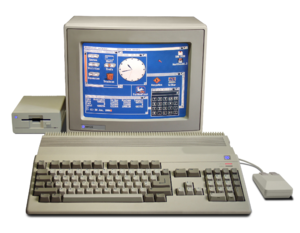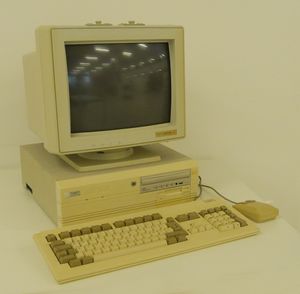Amico
| Product family | Amico |
|---|---|
| Type | Personal computer |
| Release date | March 18, 1984 (Amico 100) |
| Discontinued | 1998 |
| Operating system | AmicOS |
| Memory | 256 kilobytes and higher, expandable |
The Amico (literally, friend) is a family of personal computers introduced by Elaboratori Generale in 1984. The original model was one of a number of 16/32- and 32-bit computers that featured 256 KB or more of RAM, mouse-based GUIs, and significantly improved graphics and audio over 8-bit systems.
The Amico 100 was launched in late 1984, but production problems and a national shortage of computer chips prevented it from becoming widely accessible until mid 1986. The best selling model, the Amico 50, was launched in 1988 (along with the professionally-oriented Amico 200) and it quickly became a leading figure in the Salisfordian home computer market.
Contents
History
Concept and early development
Development of the Amico began in the mid 1970s when computer technicians working for Elaboratori Generale began researching and creating their own custom integrated circuits. Originally, these circuits performed basic functions, however the experience gained by the technicians would form the basis for Elaboratori Generale's 8-bit line of computers and later the Amico. A government stipend was granted to EG, which was given to help develop the relatively small Salisfordian computer industry at the time. EG used this stipend to design custom computer chips and hire foreign experts to help with their operations.
After the launch of EG's 8-bit line of computers, the company's R&D department began looking into developing the next generation of chipset. And work began on the chipset whch would ultimately develop into the Amico's.
In late 1983, a prototype was almost complete, and the prototype was presented at the 1983 Royal Consumer Electronics Exposition. The Amico would launch for consumer purchase in early 1984.
Launch
The Amico would officially launch on March 18th, 1984. However, due to a deal with the Salisfordian government, and difficulties with producing their custom integrated circuits, the Amico would not be available to the public until October. The Christmas buying rush of their 8-bit line and the first numbers of Amicos would help keep EG afloat, but a national chip shortage would exacerbate their problems with getting Amicos in quantity.
Early reviews of the Amico would applaud the power of its custom chipset, and would be positive overall. But, the number of Amicos produced would not be able to meet demand for the new computer system.
Commercial success
Amicos would begin to appear in quantity at the close of 1985, and Amicos would begin to sell fast in ealy 1986, however many consumers had reservations about the Amico's high price compared to other computer systems at the time.
EG would respond by bifurcating the Amico line into the Amico 50, a cost-reduced variant of the Amiga intended for the home computing market, and the Amico 200, an expanded Amico intended for the professional computing market. Due to its low price, with only a few compromises on computing power, the Amico 50 would go on to become the bestselling variant of the Amico.
The Amico found a niche in the Salisfordian professional computing market due to its adoption by the Salisfordian government, which ordered a large amount of Amicos to modernize various department's computer hardware. This adoption by the government encouraged many Salisfordian companies to also adopt the Amico, especially companies which were involved in multimedia.
Hardware
Models and variants

Amico 100
The Amico 100 was the original Amico computer released to the public. It was revolutionary compared to Elaboratori Generale's previous 8-bit line of computers, and it provided a vast amount of computing power in the hands of the end user. It also had vastly improved sound and graphical capabilities compared to previous EG computers. The Amico 100 proved to be very popular in the high-end home computing and professional computing markets.
The Amico 100 sat horizontally and had integral stands to raise it off surface it was placed on so the keyboard could be slid under the computer and stored when not in use. The included CRT monitor was intended to sit atop the computer.
The Amico 100 was originally marketed as just the Amico, but after the Amico 50 and Amico 200 released, it was retroactively renamed to the Amico 100.
Amico 50
The Amico 50 was a cost-reduced variant of the Amico. It removed a few expansion ports, was fitted with a slower CPU, and had various other compromises when it came to hardware. Despite these downgrades, the Amico 50 was able to maintain a level of computing power, sound, and graphical capabilities which was close to the original Amico 100.
Instead of the traditional Amico 100 case design, the Amico 50 was housed in a case which was similar to EG's previous 8-bit line of computers with an integral keyboard fitted in the case.
The Amico 50 found a very large popularity in the low-to-mid end home computing, hobbyist, and gaming market who were able to take adavantage of the Amico's fantastic sound and graphical capabilities.
Amico 200
The Amico 200 was an upgraded and future-proofed variant of the Amico 100. It had a larger case, a second floppy disk drive and a mutli-use bay for a hard-drive or a third floppy disk drive. It also added a number of expansion slots on the motherboard to allow the Amico 200 to be upgraded with various daughterboards after purchase. The Amico 200 also came with an expanded memory and improvements for the CPU and its co-processors.
The Amico 200 found a niche in the high-end professional computing market, as its price was too high for most home-computer users, and instead it was mainly used by design and multimedia companies.
Amico 300
By the late 80s, EG found that the trifurcation of the Amico line was resulting in an over-complication of their supply chains and a muddying of their product recognition, with some consumers unsure of which of the 3 previous computers to buy. Finding the high-end professional market was less profitable than first thought, and much better served by a dedicated professional computer rather than just a upgraded home computer, EG decided to discontinue trying to cater to the high-end market with their mainline Amico computers and instead to focus, especially in light of the Amico 50's wild success, on cost-reduction while retaining the Amico's powerful computing characteristics in their next generation of Amicos.
This resulted in the development of the Amico 300, which was released in 1991. A powerful, computer which dominated the middle-to-high end consumer computing space in the 90s. This, along with the release of AmicOS 2.5 in 1992, led to an explosion of computer-ownership in the '90s in Salisford.
Operating systems
AmicOS
AmicOS (pronounced Ami-cos) is a single-user multitasking operating system intended for use with the Amico system of computers. It was included with each purchase of an Amico. AmicOS included both a command-line interface and a graphical user interface.
Software
The Amico became particularly popular for gaming, multimedia, and demos. Developers would market a wide range of creative software and games. Popular software included 3D editors, graphics editors, video games, and music editors.
Due to the Amico's niche in the Salisfordian professional market, business applications were also developed and sold for the Amico. Most notably Schizzo, a CAD program which became very popular with engineering and design firms.
Sales
Domestic sales of the Amico
| Country | Amico 100 sales | Amico 50 sales | Amico 200 sales | Total sold | Notes |
|---|---|---|---|---|---|
| 1.9 million | 4.4 million | 0.5 million | 6.8 million | The Salisfordian market was one of the healthiest markets for the Amico. | |
| 0.3 million | 3.9 million | 0.1 million | 4.3 million | The Amico 50 was very popular in the entry-level home computing market in Creeperopolis due to its low price. | |
| 0.6 million | 1.9 million | 0.5 million | 3.0 million | Sales in Jackson were relatively good due to a lack of competition from domestic Jackian companies. | |
| 0.4 million | 0.9 million | 0.1 million | 1.4 million | Sales in Quebecshire were limited due to competition with Quebecshirite computers. |
| Country | Sales | Notes |
|---|---|---|
| Placeholder | The Salisfordian market was one of the healthiest markets for the Amico. | |
| Placeholder | Placeholder | |
| 0.8 million | Sales in Jackson were relatively good due to a lack of competition from domestic Jackian companies. | |
| Placeholder | Placeholder |
Marketing
The name Amico was chosen because it is the Salisfordian word for friend. It was intended to convey a message of user friendliness and how the Amico could be helpful to one's work.
The logo for the Amico is a blue and white checkered ball, which originates from one of the demos rendered by the prototype Amico for the 1983 Royal Consumer Electronics Exposition. This logo was printed on every Amico and almost every periphery sold by EG for the Amico computer.
The marketing for the Amico tauted its power compared to other machines on the market at the time, and its ability to be used for both professional use and for use at home. Most marketing portrayed the Amico as the future of computing.
The Salisfordian government encouraged the domestic sales of the Amico above other brands of computer to support the then relatively-small Salisfordian computer industry.
Advertisement for the Amico in Salisfordian
Advertisement for the Amico in Quebecshirite




